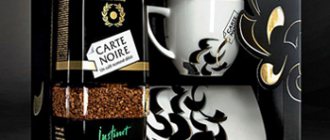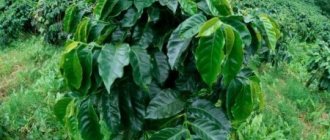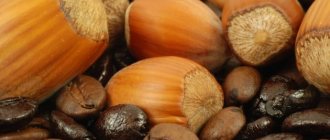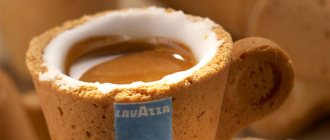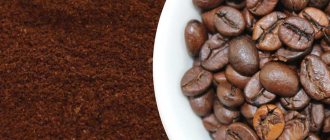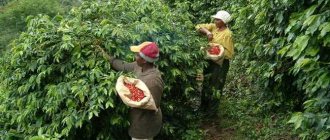July 12, 2010 Slang and terms
- Coffee
is a drink made from ground roasted coffee beans and water. Due to the caffeine content it has a stimulating effect. - Coffee
is the bean and seed of the berry of the coffee tree, which grows in a narrow subtropical zone at altitudes of up to 6,000 feet above sea level. - Coffee
is a coffee tree, an evergreen tropical plant belonging to the genus coffea of the rubiacee family.
Content
- 1 Wiktionary
- 2 Spelling dictionary
- 3 Large explanatory dictionary
- 4 Encyclopedic Dictionary
- 5 Ozhegov's Dictionary
- 6 Dahl's Dictionary
- 7 Explanatory Dictionary by Efremova
- 8 Ushakov’s Explanatory Dictionary
- 9 Types and varieties
- 10 Coffee drinks
- 11 Translation
- 12 Three faces of coffee
- 13 Coffee as medicine 13.1 Links
- 13.2 Bibliography
- 13.3 Quotes
Wiktionary
- Morphological and syntactic properties
coffee
Noun, inanimate, masculine, indeclinable (declension type 0 according to A. Zaliznyak’s classification). It is also acceptable to use it as a noun. neuter. Root: -coffee-.
- Pronunciation
MFA: units h. [?ko.f??], pl. h [?ko.f??] Pronunciation example
- Orthoepy
Outdated pronunciation: [?ko.f?]
- Meaning
- food product, coffee beans, whole or ground ? Grind coffee. ? Chocolate covered coffee. ? You can import up to 1 kg of coffee, up to 5 liters of alcoholic beverages and up to 20 packs of cigarettes duty free. “Across Borders” // “Behind the Wheel”, 2004 (quote from the National Corpus of the Russian Language, see References)
- an aromatic, invigorating, dark-colored drink, usually consumed hot, made from roasted coffee beans ? And from them two boys came out in smart clothes, and, having come to the envoy, they danced and threw themselves over their heads, then the Derbent saltan and others asked the envoy to stop near one of the gardens, which is right next to the settlements, and brought coffee and, having drunk, went to the city . “Correspondence and affairs during the embassy of Artemy Volynsky,” 1716-1718 (quote from the National Corpus of the Russian Language, see References) ? Then the father quickly finished his coffee and retired to his office. Vera Belousova, “The Second Shot”, 2000 (quote from the National Corpus of the Russian Language)
- Synonyms
- Kofiy (simple)
- Hypernyms
- product, grains
- drink, drink
- Hyponyms
- Arabica, Mocha
- Espresso, Cappuccino, Glace, Latte, Mocha, Ristretto
- Related words
- diminutive-affectionate forms: coffee pot, coffee pot, coffee pot
- other nouns: Coffee pot, Coffee maker, Coffee grinder, Coffee shop, Caffeine, Coffee
- adjectives: coffee, caffeinated
- verbs: to have coffee, to have coffee
- Etymology
From Arabic ???? (qahwa; originally meant a type of wine). In a number of European languages, the word is borrowed. through. Turkish kahve. Further origins are unknown; it is possible that qahwah came from the name of the Ethiopian region of Caffa, the birthplace of the coffee tree (in Caffa itself, coffee is called “buno” or “bunna”). Russian borrowed coffee via English coffee or Dutch koffie from tour.
Large explanatory dictionary
to about
fe, unchangeable; m. [Gol. coffie from Arabic]
- A tropical tree or shrub, with reddish berries, the pulp of which contains two seeds; a coffee tree.
- collected The seeds (grains) of this tree, from which a tonic drink is prepared. Roasted k. Do you have k. in grains?
- Powder made from roasted and ground seeds of this tree. Grind k. // A surrogate for such a powder. Instant coffee. (powder or granules that just need to be dissolved in hot water to make such a drink). // A drink prepared from such powder. K. in the East. Turkish K. Cup K. Black K. K. with chicory. Boil it. Drink it with milk.
- Drinking such a drink. Morning k. Invite to k. < Coffee (see). Coffee, coffee (-y); m. Lask. (except 1 digit). Buy a coffee. I'd like to drink some coffee. I ask you to visit Kofeyochek, -chka (-chka); m. Reduce-affection.
Preparation
An extract is made from coffee beans, and a suspension is made from cocoa beans. In other words, if you want to drink a cup of aromatic coffee, then by brewing coffee, you extract its beneficial substances into the water. And if you want a cup of hot cocoa, just mix cocoa particles with milk or water.
And one more difference. As a rule, coffee is sold roasted and can be prepared with the addition of other spices and products. That is, sometimes this drink can be called a “dish”, and cocoa powder is sold simply in its raw form.
Dahl's Dictionary
to about
fe is not inclined. coffee plant, its beans and a drink made from them. Coffee arabica. Swedish coffee, plant. Astragalus boeticu. Rye coffee. chicory, carrot, etc. burned from these substances, instead of coffee, coffee, related to coffee. - infusion, - smell, - color, dark brown, dark brown, the color of boiled coffee. Coffee house, coffee shop an establishment that sells brewed coffee and snacks. A coffee pot, a container of various types, for brewing coffee. | Hunter drinking coffee. -nitsa a tin or other container with a lid for storing burnt and sometimes ground coffee. | Lover of this drink. | A fortune teller using coffee grounds. Make coffee, drink coffee. Coffee shop and. the court rank of caretaker for coffee, tea, chocolate, etc. who, at court, goes for hot food.
Production
Drying and peeling of fruits
To begin with, the coffee beans are harvested, a process still done by hand. The fruit is then dried and peeled using one of two methods.
The dry method is a more ancient, primitive and labor-intensive process. The fruits are laid out in the sun and raked and spread out again several times during the day. When they dry out to the point that they contain only 12 percent water, the pavers become wrinkled. At this stage they are processed manually or by machine.
When using the wet method, the husks are removed before drying. The fruits are first processed in a pulping machine, which removes most of the material surrounding the beans, but some of this glue coating remains after the pulp is cooked. This residue is removed by adding enzymes in tanks where their natural enzymes digest the sticky substance over a period of 18 to 36 hours.
Once removed from the fermenting tank, the beans are washed, dried with hot air and placed in large mechanical mixers called hullers. Huller will polish the beans to a clean, glossy finish.
Cleaning and sorting beans
The beans are then placed on a conveyor belt, which carries them past workers who remove sticks and other debris. They are then graded based on the size, location and height of the plantation where they were grown.
Once these processes are complete, workers select and package specific types and grades of beans to fill orders from the various roasting companies that will complete the bean preparation. When beans (usually robusta) are harvested in undesirable conditions—hot, humid countries or coastal areas—they should be shipped as quickly as possible, as such climates are conducive to insects and fungi that can seriously damage the cargo.
When the coffee beans arrive for roasting, they are again cleaned and sorted using mechanical devices to remove leaves, bark and other remaining debris. If the beans are not supposed to be defatted, they are ready to be roasted.
Decaffeination
If coffee can be defatted, this is done using two methods. The first is using a solvent, the second is called aqueous.
In the first process, coffee beans are treated with a solvent (usually methylene chloride) that leach out the caffeine. If this degreasing method is used, the beans must be thoroughly washed to remove any traces of solvent before roasting.
The water method involves steaming the beans to bring the caffeine to the surface and then scraping off that caffeine-rich layer.
Burning
The beans are roasted in huge commercial roasters according to procedures and specifications that vary between manufacturers (specialty shops typically buy the beans directly from the growers and roast them on site). The most common process involves placing the bean in a large metal cylinder and blowing hot air into it. An older method called staggering requires placing the beans in a metal cylinder, which is then rotated over an electric, gas or coal heater.
Regardless of the method used, roasting gradually raises the temperature of the beans to 220-230 degrees Celsius. This causes the release of steam, carbon monoxide, carbon dioxide and other volatiles, reducing the weight of the beans by 14 to 23 percent. The pressure of these escaping internal gases causes the beans to swell, increasing their volume by 30 to 100 percent. Roasting also darkens the color of the beans, gives them a crumbly texture, and causes chemical reactions that imbue the coffee with its familiar aroma (that it has not yet possessed).
After roasting, they are placed in a cooling vessel in which they are mixed while cold air blows on them. If the brewed coffee is of high quality, the cooled beans will now be sent through an electronic sorter equipped to detect and eliminate beans that come out of the roasting process too light or too dark.
If the coffee is pre-prepared, the manufacturer injects it immediately after roasting. Special grinding types have been developed for each of the different types of coffee makers, as each is best suited for coffee of a certain fineness.
Instant coffee
If coffee must be instant, then it is brewed using water in huge percolators. The extract is purified from the brewed coffee and sprayed into a large cylinder. As it falls down through this cylinder, it enters a warm air stream that turns it into a dry powder.
Package
Whole coffee beans are less susceptible to loss of aroma and flavor than other types of coffee and are usually packaged in foil bags.
Pre-ground coffee should be hermetically sealed, as it retains its basic qualities less well. It is usually packaged in impermeable plastic film, aluminum foil or cans.
Instant coffee easily absorbs moisture, so it is vacuum packed in tins or glass jars before shipping to retail stores
Making coffee video
Ushakov's Explanatory Dictionary
to about
fe neskl., m. kofi (colloquial) avg. (from Arabic kahva - wine, from the name of the country in Africa - Kaffa). Beans of a tropical plant - the coffee tree. Coffee beans. Ground coffee. Roasted coffee. || A drink made from these grains, roasted and ground. To drink coffee. Mocha. Black coffee. (without cream). Warsaw style coffee. Then he drank his coffee. Pushkin. || A surrogate for this product. Malt coffee. Barley coffee. Coffee made from wine berries.
The portal Gramota.ru states that “ Strict literary norms prescribe the word coffee to be used as a masculine noun: strong coffee has already cooled down. However, in casual oral speech, neuter agreement is acceptable: the coffee is cold.
»
In 2009, the spelling dictionary of the Russian language, edited by Bukchina, in particular, recognized that the word “coffee” now has not only a masculine, but also a neuter gender.
Myth No. 5. Coffee is a legume plant.
Fact. Did you know that coffee beans are only called coffee beans, just like cocoa beans, but they are not technically beans. They are called that only because their appearance resembles legumes. The truth is that coffee beans are fruits that ripen on coffee trees. We have previously told you about how coffee is grown.
Types and varieties
In nature, there are about 80 species of coffee trees - from dwarf shrubs to 10-meter giants. Man widely cultivates two types of coffee tree for his needs: coffea arabica - Arabica
, coffea canaphora (robusta) -
Robusta
.
According to various estimates, these two types account for up to 98% of the coffee produced. This volume is divided in the ratio of 70% - Arabica
, 30% -
Robusta
. The remaining types account for only 2% of world coffee production.
The most common variety of coffee, Arabica, grows at an altitude of 600 to 2000 meters above sea level. Beautifully shaped beans usually have an oblong shape, a smooth surface, a slightly curved “S”-shaped line, in which, after light roasting, unburned particles of coffee berries usually remain. The Robusta species is fast-growing and more pest-resistant than Arabica, and grows from approximately 0 to 600 m above sea level, primarily in tropical areas of Africa, India and Indonesia. The grains have a round shape, color - from light brown to grayish-green.
Robusta is generally considered less refined in terms of flavor. At the same time, Robusta contains more caffeine and is also often used in espresso blends, which allows for better coffee crema and reduces the cost of the mixture.
Other varieties, such as Liberica
and
Excels
- have no industrial significance.
Growing coffee on plantations
Rare connoisseurs of the invigorating drink have seen with their own eyes what coffee grows on and know the entire cultivation process. Let's try to recreate pictures from a coffee plantation in words:
- After processing, the seed is placed in temporary greenhouses for germination. Shoots appear after 2.5 months, grown seedlings with the first leaves are transplanted into individual containers and placed in greenhouses.
- The greenhouse growing time for coffee seedlings reaches 6-12 months, then the tree is transplanted to a permanent place. The site should be located in a place protected from bad weather, at an angle to the sun's rays.
- Sometimes farmers use open plantations for seedlings, rightly believing that this method hardens the shoots and adapts them to equatorial conditions. Such areas are lined with tall shrubs to protect them from the burning sun, wind and rain.
After three years, the stronger coffee blooms for the first time. The spectacle is of incredible beauty; the flowers vaguely resemble jasmine. The tree blooms with lightning speed: in three days. The first fruiting is weak. Real harvests begin when coffee plants are 5 years old.
How a mature coffee tree grows and how its fruits are harvested:
- red (less often purple) coffee berries are collected in large elongated clusters;
- The ripening period for coffee berries is 8-11 months (depending on local growing conditions);
- Harvesting by region is carried out at different times: in Brazil - in May-September, in America - in October-March, on African plantations - from October to April;
- under plantation conditions, the growth of the coffee tree does not stop and without pruning it can reach up to 9 meters; pruning is carried out up to 3 meters.
The best yields are from 8-15 year old trees. Fruiting continues longer (up to 50 years), but the quality of the berries is no longer the same. Manual harvesting is complemented by mechanized harvesting. A harvester goes through the plantation and shakes off the coffee clusters, then the fruits are sorted by hand. Machine harvesting is carried out on flat areas with uniform ripening of the berries, so farmers’ hands are often the only tool.
World “coffee belt”: in which regions of the planet coffee is grown
Wild and cultivated coffee trees are grown in 65 countries. They are located along the equator, forming the coffee belt of the planet. It is humid here, there are plenty of solstice days, and there are no temperature changes that are destructive for coffee.
Geographical boundaries of the coffee belt:
- 10 degrees north latitude and 10 degrees south longitude;
- the territory lies in the Tropics of Cancer and Capricorn;
- More than half of the world's plantations are located in Central and South America, followed by Africa, and Southeast Asia closes the list.
American continent. High quality grains are produced in Brazil, Colombia, and Peru. There are productive plantations in Ecuador, Guiana, Paraguay, Bolivia, and Venezuela.
Africa. The air here is drier, there is a lot of sun. Coffee plantings are cultivated in Ethiopia, Uganda, Kenya, Uganda, Zimbabwe, Angola, and Congo. Asian countries have good market positions - fruits are grown and harvested in Vietnam, Indonesia, and India
The production of the drink from imported raw materials is carried out far beyond the equator. Varietal black and green coffee from roasted beans is obtained in Italy, Turkey, Russia, China, and the countries of Southeast Asia.
Coffee drinks
There are many coffee-based drinks. They differ in cooking methods, ingredients and proportions, taste and aroma. The main ones can be considered Espresso
,
Oriental coffee
,
French press
,
Moka
,
Filter coffee
,
Instant coffee
.
There are many varieties of espresso: Ristretto
,
Lungo
,
Americano
.
By mixing espresso and steamed milk into a fine foam in certain proportions, you can prepare coffee and milk drinks Cappuccino
,
Latte Macchiatto
,
Espresso Macchiatto
.
Translation
Coffee is loved and drunk all over the world; coffee is the second (after water) most popular drink in the world. And in every country they call it, write it, prepare it and drink it differently. Here's how to spell coffee in some languages:
- Italy: Coffea
- England: Coffee
- France: Cafe
- Greece: Kafes
- Spain: Cafe
- Germany: Kaffee
- Holland: Koffie
- Norway: Kaffee
- Denmark: Kaffe
- Finland: Kahvi
- Ukraine: Kava
- Belarus: Kava
- Poland: Kawa
- Czechoslovakia: Kava
- Hungary: Kave
- Türkiye: Kahve
- Israel: Kave
- Iran: Gehve
- Iraq: Qahwa
- Lebanon: Qahwa
- Emirates: Kahwa
- Egypt: Masbout
- Ethiopia: Buna
- Kenya: Kalawa
- China: Kafei
- Japan: Koohii
- Laos:Cafe
- Thailand: Gafae
- Philippines: Kape
- Hawaii: Kope
- Indonesia: Kopi
Three faces of coffee
Coffee can come in three forms: as an aromatic drink, as a medicine, and as a poison. There is nothing unnatural in this, at first glance, unexpected combination, since coffee affects each organism differently. After a cup of coffee, most people feel cheerfulness, a surge of energy, increased efficiency and improved mood, while some, on the contrary, feel uneasy from just the smell of coffee. For such people, even one cup of drink can cause insomnia, headaches, high blood pressure, and anxiety. In addition, some people fall asleep without problems after drinking coffee, while others cannot sleep a wink.
Why drinks are good for your health
Coffee and cocoa are natural products, which means they are a priori beneficial. However, there are many differences between them, starting with biology - they belong to different plant families. Another significant difference is in their chemical composition; they have different stimulants - coffee contains caffeine, and cocoa contains theobromine.
The value of coffee lies in the caffeine, which gives vigor and energy. This drink stimulates in moments of fatigue, and for many people it is familiar and irreplaceable in the diet. Cocoa is a source of theobromine, whose properties are similar to caffeine. This stimulant is successfully used in medicine.
Drinks made from cocoa are indispensable in baby food; they have a beneficial effect on the heart due to their high magnesium content; the best antidepressant in the form of chocolate is also made from cocoa.
Coffee
The stimulating effect of coffee is associated with the presence in coffee beans of a substance such as caffeine, which contains alkaloids. This tandem affects the cardiovascular and central nervous systems, increasing the performance of the entire human body.
Coffee is considered a pure energy drink and is useful as a powerful natural stimulant. It improves memory and concentration, speeds up metabolism and prevents depression, diabetes and Parkinson's disease. Coffee fights cancer; this is facilitated by the antioxidants it contains in large quantities.
Coffee has the greatest effect in preventing skin cancer.
Coffee as medicine
The extraordinary properties of coffee are remembered in the ancient legend about Sheikh Omar, a doctor and priest who lived as a hermit in a cave. According to legend, the sheikh treated the sick who came to him with this miraculous decoction of the fruits of the coffee tree.
Even before 1000 AD. The Arab physician and alchemist Rhazes in his writings described the medicinal properties of the drink “binchum” - i.e. coffee. At that time in the East it was believed that coffee accelerates thought, cheers the heart, treats eye diseases, and is an excellent remedy for gout, dropsy and scurvy. "Kawa" in Arabic means "to be strong", "active", "to strengthen".
Despite the fact that many famous legends and stories about coffee say that this drink was used in ancient times to treat various diseases, at present there is no exact data whether coffee was originally used as a drink or as a medicine. However, the wonderful properties of coffee fruits were noticed by scientists, doctors and chefs, thanks to whom we now enjoy this wonderful drink.
Top 10: Weird facts about coffee
Coffee is one of the most consumed drinks in our society. It has become an everyday part of the lives of many people who enjoy the aroma, taste, energy and attention the drink brings. Coffee has a rich history. From the coffee beans, to the way each special drink is prepared, to where the names of the coffee drinks come from. Coffee is one of the great drinks of our time and its enjoyment is appropriate in various situations, from breakfast to meetings or evening gatherings. With such a variety of choices, it is not difficult to find something that will suit the taste of a person with any needs. In the list you will learn ten facts about coffee that most people are not familiar with. 10. Coffee is potentially dangerous
By now, many of us know that being first at something is always a big deal.
When someone experiences or does something for the first time, he becomes an original, a special pioneer in some way. Coffee was the first to do something very specific. Apparently, coffee was the first food to be freeze-dried. This happened in 1938 when the Nestlé coffee company invented freeze-dried coffee. This was an unprecedented new milestone and set a new standard for how food could be packaged and sold. This new variety of coffee was convenient for many different reasons and allowed consumers to choose how they wanted their coffee to be purchased. 7. The second most traded product on Earth
Throughout history, in fact, not all people liked coffee. Although there are currently people who do not drink it, or prefer decaffeinated coffee, the drink was banned by Muslim rulers in the 16th century. Alcohol was also prohibited in such communities. But coffee was banned only after those who drank it began to experience certain, specific side effects. Muslim rulers found the stimulant effect of coffee offensive. Although the ban did not last long, the incident showed that coffee was a powerful stimulant that had noticeable effects. Some of them are desirable, while others can be problematic. Still, if coffee helps you wake up and work actively all day, then it’s worth appreciating, isn’t it?
Quotes
- Coffee and Cigarettes (film)
- Let's pretend this coffee is champagne. - Why should we do this? - Well, to celebrate life. You know how rich and elegant people do it, cool people. — I prefer coffee, the coffee of a simple working man. “You’re so provincial, Bill!” Do you know what your problem is? - What? -You have no joy in life.
- Burnt by the Sun (film)
- What will you do? Tea with jam or coffee with milk? - Coffee with jam...
(No ratings yet)
water pump
Previous post
Saeco Talea
Next entry
Planter's find
According to Neto, all the living things that come back to the farm after eliminating pesticides are important to "naturally restore the balance that was lost in the process of tending the monoculture." Therefore, having noticed a cluster of ants near the trees, he did not destroy them. And one day, while walking through the hacienda, I saw peeled berry seeds (coffee beans) scattered around the trees. Then Joao took a closer look and realized that the ants knock coffee berries from the trees and take them to the anthill to feed the pulp to the larvae, and then throw the seeds, that is, coffee beans, outside the home.
Light green and more: the most fashionable colors of this season are named
“We are full of anxiety”: Al Bano announced his desire to be vaccinated with Sputnik V
New Instagram app for kids is being developed from Facebook
The ants left behind enough beans to fill a large coffee grinder, and Neto collected them in a bag to examine and examine closely. He told longtime client and friend Katsuhiko Hasegawa about the discovery. A Japanese man, who has been purchasing coffee from Neto since 1990, wanted to know what taste qualities “ant beans” have.

